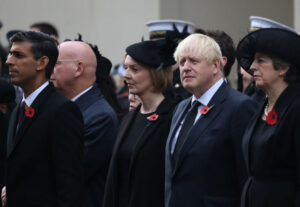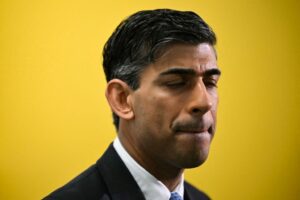That American authority is shot. That an accord and relationship will have to be established with illiberal governments. That the dominance of the dollar is over. That the world will be defined from here on out by “multipolarity”, with Britain as a slightly villainous clearing house, bolthole and broker to all sides.
This, in its broad outlines, is now the unifying worldview of the Brics powers: a loose pact of frenemies — currently assembled in the city of Kazan — with whom, according to General Sir Patrick Sanders, we are on the brink of war.
But 10 years ago, this was also nothing less than the official policy of the British government. Britain was the first country — not Russia — to follow multipolar world theory as a guiding principle: the term Brics was coined by the British economist Jim O’Neill, and the country would also produce When China Rules The World, the smash-hit prophecy of American decline. America may have started to “decouple” from China almost a decade ago, but Britain still looks to Beijing as its natural source of foreign investment, as David Lammy’s visit this week proves. To Britain’s governing classes, the collapse of Lehman Brothers in 2008 was decisive proof that American hegemony was finished, and that Britain could no longer live off the fat of its dividends. This global system had now crashed, and it wasn’t at all certain that the country would now be able to maintain the lifestyle to which it had grown accustomed.
The times called for a new savvy. Concessions to changing global conditions would have to be made. Some scruples, such as the precise domestic arrangements of trading partners, or rules on foreign ownership, would have to be put aside.
This was the political economy of Cameronism. Everyone agreed that Britain, especially now, was a genteel legacy power; and it would have to traffic in this legacy to eke out first-world living standards.
It would mean selling off the last of the stored imperial wealth. It would mean, still more, the relentless merchandising of British heritage brands abroad. If Britain could not win the new Brics powers for liberal democracy, then it might yet win them for Dulwich College, the House of Windsor, and Macallan single malt. The new oligarchs would stash their wealth at British banks; British lawyers and law courts would handle their commercial disputes. They would hunt its fields, fish its rivers, buy its townhouses, and educate their young at its ancient schools — so many of them, in fact, that by 2016 St Paul’s School, George Osborne’s alma mater, would have to introduce a special bursary for the upper-middle classes as fees ballooned.
Few could see any alternative. Niall Ferguson, then something of a house historian to the Cameronite project, glibly predicted in 2011 that 10 years hence, Britain would be coasting off of Chinese foreign investment; Chinese purchases of Chelsea townhouses; and Chinese ownership of Scottish shooting estates.
But above all, this analysis was the making of George Osborne, Chancellor of the Exchequer between 2010 and 2016. Osborne lives in history as the austerity chancellor. Getting on for a decade after his fall, cuts to public expenditure are still held as an example of ‘Osbornomics’, and people like Rachel Reeves still feel the need to distance themselves from his legacy. But what really animated George Osborne was this diagnosis of Britain’s place in a post-Lehman world, of which David Lammy’s recent reset of relations with China is a faint echo.
At every turn, Osborne sought to sharpen the lines that Cameron hoped would stay pleasingly blurred. As his early biographer, Janan Ganesh, notes, those Conservative colleagues who held to pre-1997 cultural views were for Osborne not merely old-fashioned but troglodytic. For someone such as David Cameron, for whom the Conservative Party is a kind of social forum, the eventual apostasy of Michael Gove and Boris Johnson over the European issue came as a genuine shock. It did not shock Osborne.
He, too, carried furthest the Cameronite idea of Britain’s place in a post-American age. When it came to business-like relations with China, it was the “Osborne Doctrine” that The Economist wrote of, not the Cameron Doctrine. For him, competition in a multipolar world demanded that Cameronism be carried to its logical conclusion: that Britain really become a svelte, socially liberal entrepôt, open for business with anyone and everyone. This was the conceit. And it forms part of an emerging folk history of the 2010s as a period of liberal oligarchy; a never-ending party for dodgy donors and Brics influence-peddlers in which nothing was sacred and all was for sale. This glittering world, as the narrative goes, was eventually brought to an end by Brexit, lockdown, and the de-globalisation that they imply.
It isn’t hard to see why. Osbornism, as a positive economic vision beyond the simple fiscal retrenchment known as austerity, quickly became associated with the fire sale of cherished national assets to overseas buyers. The beloved chocolatier Cadbury was bought by Kraft in 2010; the Chinese firm Geely acquired London’s fleet of black cabs in 2013. By 2016, up to a third of the student body of the ancient boarding schools was drawn from overseas. In a bid to attract further Chinese investment, Cameron and Osborne declined to support anti-dumping measures, sending British Steel into a tailspin that ended with its acquisition by a Shijiazhuang-based industrial concern in 2019.
Osbornism was also supposed to mean the economic dominance of London. Much was made of the idea that Osborne had enjoyed a metropolitan upbringing, and that the squirearch milieu of Chipping Norton meant little to him. For Osborne, it was said, London was Britain’s real proposition to the world: as a discreet provider of professional services, and as a global playground for Brics oligarchs. Osbornism had ostensibly created the tax and visa conditions for just this. Canary Wharf, the Shard, and a 20% stake in the London Stock Exchange were bought up by the Qataris, and the growth of a “Moscow-on-Thames” was watched with smiling equanimity. This was held to be an example of the new ruthless national accounting post-crash, funded at the expense of the luckless provinces in the country’s north.
Capstone to the system of Osborne was the “Golden Era” of relations with China. Again, Osborne took this idea further than most. Engagement with China did not simply mean investment, but a full economic partnership. This had a logic. Before the decade was out, the European Union and the United States were once again making threatening noises about Britain’s position in Northern Ireland. In these circumstances, would it have been so bad to have in China an economic and diplomatic counterweight? The announcement, in March 2015, that Britain would be joining the Chinese-run Asian Infrastructure Investment Bank (AIIB) was a real coup, one that shocked and angered Washington. As one of the first practitioners of “multipolar world” theory, George Osborne had — perhaps by accident — produced a twitch of something like real strategic independence. If nothing else, Osbornism on the world stage hinted, however briefly, that there might be some alternative for Britain to the thankless enforcement of a rules-based international order, an order which, in the 2020s, does not permit Britain to control its own sea border.
These were cultural events more than they were economic ones. According to the tropes of the time, they spoke to a nation adjusting to stately poverty, whose traditional patterns of life were now sustained only by foreign money. But for Osborne, this was only what the moment demanded. Britain required a brute lesson of its place in the new world — a lesson which Osborne would administer, and of which the sale of flagship national assets was a symbol.
But there was always more theatre than reality to Osbornism. His public image was one of ruthlessness and hard choices, and so went the black cabs, the public schools, the legacy steelworks, along with other marquee national real estate like the Old War Office and the Admiralty Arch, which were both flogged on the cheap. So too was the practice — recently revealed — of selling cheese-tasting courses, magic lessons, and tennis matches with Conservative ministers to wealthy investors like Mohamed Amersi. Fiscal trifles by themselves, but seen by all as a sign of the moral compromises that Britain would now have to make. The fixation on curios like a direct flight from Manchester to China or a special visa for Chinese businessmen furnish two more examples.
All this could be presented as a kind of necessary stooping to conquer in the new Brics world, but none of them even made much money in the first place. Needless to say, no new era of svelte globalism resulted. In 2015, at the height of Osborne’s political fortunes, foreign investment stood at 1.54% of GDP — less than in France, that economic clamshell, where the figure was 1.76%. For all the talk of a “global race”, Britain left the first half of the 2010s no more globalised than it had previously been.
What Osbornism represented, in unconscious terms, was the anxiety felt by a governing class convinced of national decline after 2008, but which baulked at the possible solutions. By 2015, there was no entrepôt and no global playground, but there was much of the attendant seaminess. This was a system that had all the trappings of an oligarchy, but none of its possible enjoyments. And this pretend oligarchy began to decompose almost as soon as it was assembled. As the British economy flickered back to life, Osborne embarked on a reversal of course that would undo much of his own work. First to be walked back on was the idea of Britain as a bolthole for the global plutocrats of tomorrow. In 2015, Osborne levied an “oligarch tax” on sales of homes by non-UK residents, and called for action against the financial networks that had been exposed in the Panama Papers. Boris Johnson, then the Mayor of London, publicly opposed both of these ideas. Barely a year before the Brexit referendum, then, it was Johnson who was cast as the defender of liberal globalisation, and Osborne who criticised its excesses — the complete opposite of later alignments.
Osborne was also the first to call time on the dominance of London. As soon as the capital began once more to turn a surplus, George Osborne cast around for ways to cream it off and spread it elsewhere. Osborne was the great sponsor of northern devolution, and patronised the idea of a directly elected Manchester mayor. And it was Osborne, not Theresa May, who first played the card of the regions, of London against the “left-behind”. Years before anyone had heard of Levelling Up, George Osborne was the champion of a Northern Powerhouse — such a champion, indeed, that the idea began to dominate talks with the Chinese during his last year in power. These kinds of hang-ups are not usually the subjects of international trade and diplomacy. It was a strange kind of myopia, and it spoke much more to a Little England self-involvement than Brexit ever did.
Flushed with victory after the election of 2015, Osborne was already putting together an agenda for his own premiership, which, among other things, would have seen state expenditure further reduced to around 35% of GDP. This, after the previous five years of cuts, was justified again and again with reference to the international situation — the need for a leaner and possibly meaner Britain in a post-American world. Had this plan succeeded, something like real economic liberalism would have been created in Britain. To accomplish it, Osborne planned to strengthen the party’s ties with those former Liberal Democrats who had delivered the victory of 2015: asset-rich, rural, generally older, either retired or disproportionately employed in the public sector.
A strange choice. Such a group, flushed with assets and state pensions, were the current economy’s main beneficiaries, and had no interest in overturning it. Osborne was attempting to carry out a programme of economic liberalism through the agency of some of the most reactionary classes in England. But as an ideology, Osbornism became evermore reliant on these places so that, in 2024, the two — by a strange twist — are now treated as virtually synonymous. In practice, Osborne’s plan to slash the size of the state was a demagogic one, and it required a demagogic course. It would have meant a popular appeal to the lower-middle classes — the only reliable constituency for economic liberalism. As with so much else, Osborne shrank from the means, and he left it to rivals Boris Johnson and Michael Gove to make such an appeal.
Osbornism, as a distinct ideology, has left almost no material legacy. It was always a politics of phrase and image, and it vanished at a word. In 2024, London is manifestly not the global playground it was meant to be. It is shifty candy stores that now set the tone of its main streets, not the scions of sheiks and the CCP. With furlough in March 2020, the six years of budgetary austerity that compromised the domestic side of this agenda were undone at a stroke, and ideas of a leaner, more competitive Britain were all but forgotten. The Emirati bid for The Spectator and the Telegraph — for which Osborne acted as a consultant — failed, and the door is now to be closed on any future such acquisitions. The Chinese investment is now largely gone, and “Moscow-on-Thames” was quickly rolled up, with old Cameronite retainers like Evgeny Lebedev now figures of suspicion. Osborne is the only national figure on the centre-right who still makes the case for a ‘Northern Powerhouse’, his old party colleagues having now soured on devolution. In 2024, the sole physical marker of Osbornism is a folly: a fairly miserable English leg of the Chinese “One Belt One Road” initiative, a rail line that shudders to a halt in a field near Barking. Far from being a vein of commerce, it is only used once a week, to ship 34 wagons of tourist merchandise to the city of Yiwu. It’s a symbol of a future that never was; an oligarchy that never was; a strange personal affect dreamt up in a moment of panic, and soon dropped.
Instead, Osbornism’s true legacy lies in its phrases, which are still with us today. It can be found in the idea that there exists a popular force of Cameron Ultras in the shires: a “Blue Wall”, whose salient characteristic is social liberalism, rather than being very rich. Whenever we are told that this entirely hallucinated demographic would have no truck with action on illegal migration or a moderation on Net Zero, we are hearing the echo of Osbornism.
As an actual agenda, though, Osbornism was a phantasm; a devilish idea that flickered briefly across the national consciousness and disappeared. What if England really was run to make money? We have yet to find out.
Disclaimer
Some of the posts we share are controversial and we do not necessarily agree with them in the whole extend. Sometimes we agree with the content or part of it but we do not agree with the narration or language. Nevertheless we find them somehow interesting, valuable and/or informative or we share them, because we strongly believe in freedom of speech, free press and journalism. We strongly encourage you to have a critical approach to all the content, do your own research and analysis to build your own opinion.
We would be glad to have your feedback.
Source: UnHerd Read the original article here: https://unherd.com/





